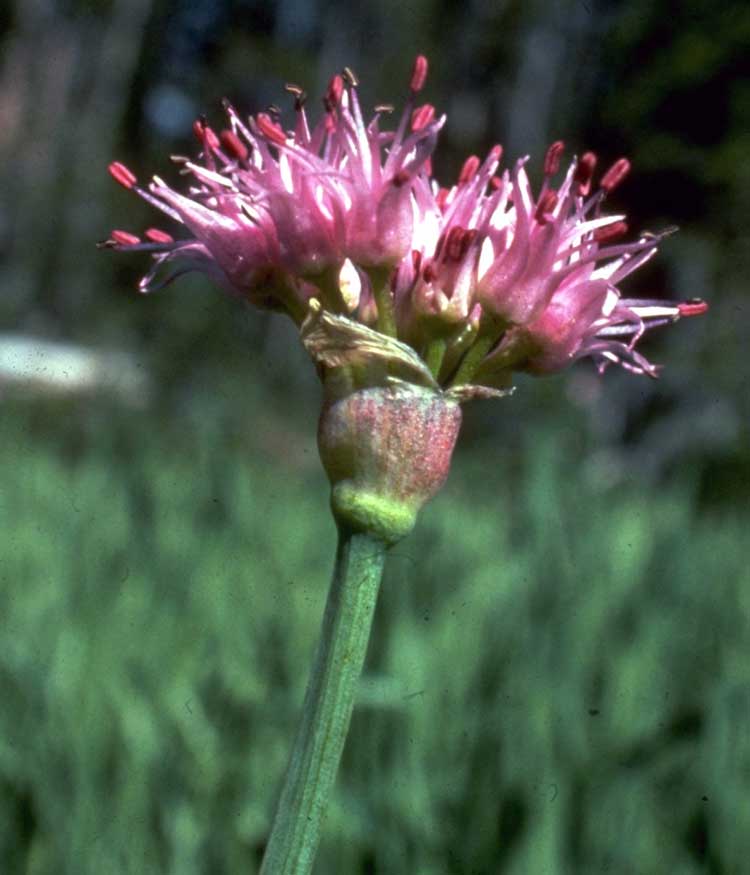
Allium validum (Photo: USDA)
Classification System: APG IV
Superregnum: Eukaryota
Regnum: Plantae
Cladus: Angiosperms
Cladus: Monocots
Ordo: Asparagales
Familia: Amaryllidaceae
Subfamilia: Allioideae
Tribus: Allieae
Genus: Allium
Species: Allium validum
Name
Allium validum S.Watson
Distribution
Native distribution areas:
Continental: Northern America
British Columbia; California; Idaho; Nevada; Oregon; Washington
References: Brummitt, R.K. 2001. TDWG – World Geographical Scheme for Recording Plant Distributions, 2nd Edition
References
Watson, S., Botany (fortieth parallel) 350. 1871 (in C. King, U.S. geol. explor. 40th Parallel vol. 5)
Links
Govaerts, R. et al. 2018. Allium validum in World Checklist of Selected Plant Families. The Board of Trustees of the Royal Botanic Gardens, Kew. Published online. Accessed: 2018 Jul. 25. Reference page.
International Plant Names Index. 2018. Allium validum. Published online. Accessed: Jul. 25 2018.
USDA, ARS, Germplasm Resources Information Network. Allium validum in the Germplasm Resources Information Network (GRIN), U.S. Department of Agriculture Agricultural Research Service. Accessed: 08-Apr-12.
Vernacular names
English: swamp onion
Allium validum is a species of flowering plant commonly called swamp onion, wild onion, Pacific onion, or Pacific mountain onion. It is native to the Cascade Range, to the Sierra Nevada, the Rocky Mountains, and other high-elevation regions in California, Oregon, Washington, Nevada, Idaho and British Columbia.[2][3] It is a perennial herb and grows in swampy meadows at medium and high elevations.[4]
Taxonomy and morphology
The Allium validum bulb is three to five centimeters long, ovoid and clustered on the short end. The outer coat of the stout rhizome is brown or gray in color, fibrous, and vertically lined. The stem is 50 to 100 centimeters long and angled. There are three to six leaves more or less equal to the stem and the leaves are flat or more or less keeled. There are 15 to 40 flowers with pedicels being seven to twelve millimeters in length. The flower itself is six to ten millimeters, its perianth parts are more or less erect, narrowly lanceolate, acuminate, and entire with a rose to white color. The stamens are longer than the tepals, and there is no ovary crest.[2][5][6][7][8][9]
Ecology
This is a common plant in California often found in wet meadows at elevations of 1,200 to 3,400 meters (3,900 to 11,200 ft). A. validum prefers sandy and loamy soils and requires well-drained soil. The plant will grow in acid, basic, or alkaline soils, but only in areas with plenty of moisture and sun.[2]
Ethnobotany
The bulb A. validum can be used as a flavoring for soups and stews although it is somewhat fibrous. The leaves can be eaten raw or cooked and the flowers can be used as garnish on salads.[10]
Plant toxin insecticide
It can also be used as a moth repellent. The whole plant is said to repel insects and moles.
References
Lansdown, R.V. (2017). "Allium validum". The IUCN Red List of Threatened Species. IUCN. 208. e.T80603050A80958507. doi:10.2305/IUCN.UK.2017-3.RLTS.T80603050A80958507.en.
"Allium validum in Flora of North America @ efloras.org". efloras.org.
BONAP (Biota of North America Program) floristic synthesis, Allium validum
"Allium validum". Lady Bird Johnson Wildflower Center. Archived from the original on 2007-07-14. Retrieved 2021-12-20.
Botany - Biodiversity Heritage Library. biodiversitylibrary.org. G.P.O. 1871.
"Image". tropicos.org.
Cronquist, A.J., A. H. Holmgren, N. H. Holmgren & Reveal. 1977. Vascular Plants of the Intermountain West, U.S.A. 6: 1–584. In A.J. Cronquist, A. H. Holmgren, N. H. Holmgren, J. L. Reveal & P. K. Holmgren (eds.) Intermountain Flora. Hafner Pub. Co., New York.
Hickman, J. C. 1993. The Jepson Manual: Higher Plants of California 1–1400. University of California Press, Berkeley.
Hitchcock, C. H., A.J. Cronquist, F. M. Ownbey & J. W. Thompson. 1969. Vascular Cryptogams, Gymnosperms, and Monocotyledons. 1: 1–914. In C. L. Hitchcock, Vascular Plants of the Pacific Northwest. University of Washington Press, Seattle.
"Allium validum Swamp Onion, Pacific onion PFAF Plant Database". pfaf.org. Retrieved 2021-12-20.
Sources
California plants for education, research and conservation. [web application]. 2006. Berkeley, California: The Calflora Database [a non-profit organization]. Available: https://web.archive.org/web/20181117025044/http://calflora.org/. (Accessed: Feb 24, 2006)
Jepson Flora Project: Jepson Interchange. Copyright © 1993 by the Regents of the University of California [web application] Treatment from the Jepson Manual. Website: https://web.archive.org/web/20100307223540/http://ucjeps.berkeley.edu/ (Accessed: Feb 24, 2006)
Plants For A Future - Species Database. Copyright © 1997–2000. [web application]
WEB search engine by Rich Morris. Plants for a Future, Blagdon Cross, Ashwater, Beaworthy, Devon, EX21 5DF, UK. Website: www.pfaf.org (Accessed: Feb 24, 2006)
USDA, NRCS. 2006. The PLANTS Database, Version 3.5 (http://plants.usda.gov)[permanent dead link]. Data compiled from various sources by Mark W. Skinner. National Plant Data Center, Baton Rouge, LA 70874-4490 USA. (Accessed: Feb 24, 2006)
Retrieved from "http://en.wikipedia.org/"
All text is available under the terms of the GNU Free Documentation License

